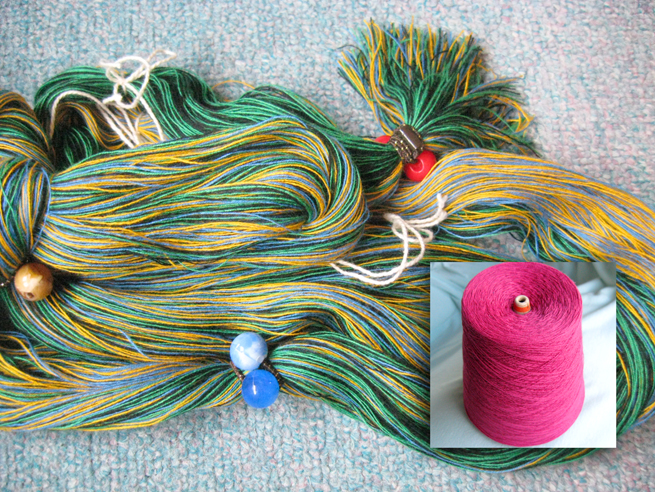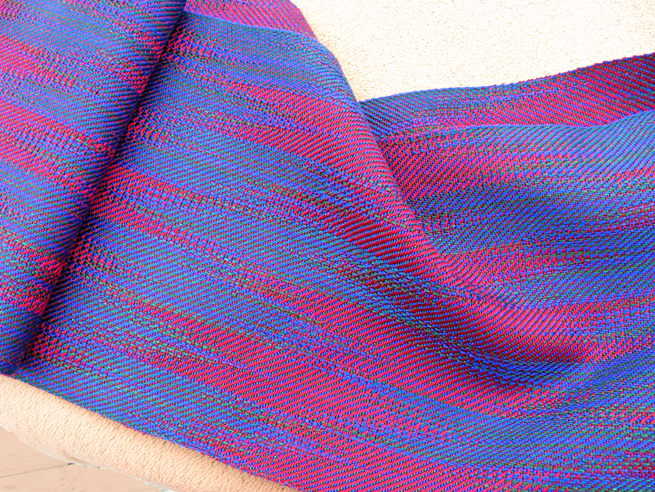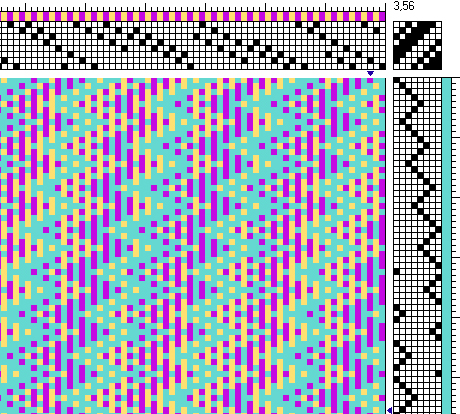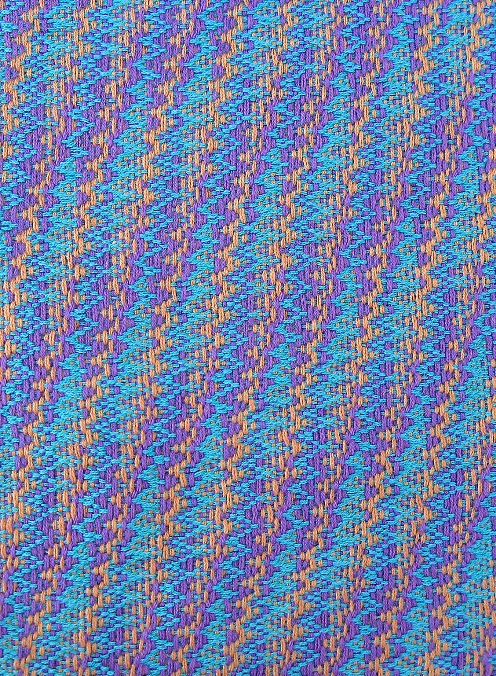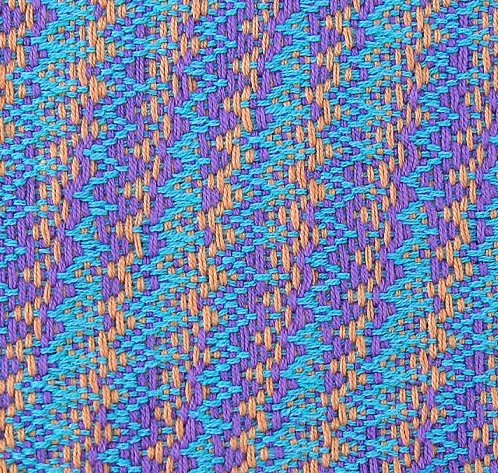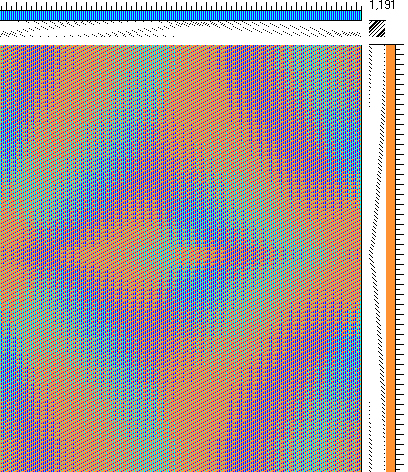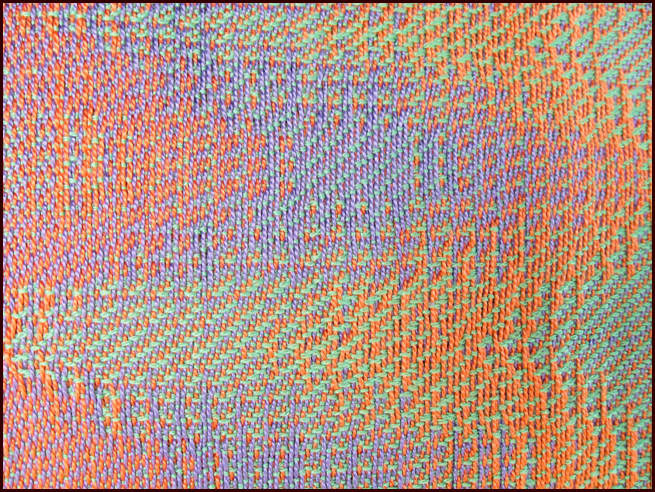The next step in my weaving experience with turned taqueté was to try some variations. While I was browsing through Marian Stubenitsky’s amazingly beautiful book, Weaving with Echo and Iris, I came across an 8-shaft draft in Chapter 7 of a turned taqueté variation with a different interval – the threading is designed with an interval of 3 instead of the usual 4 as in true turned taqueté. I designed a few drafts this way on 8 shafts, chose one I liked and wove some yardage. I also experimented with another turned taqueté variation that was inspired by my fascination with interleaved threadings. The drafts I designed this way looked very interesting and so this time I chose a 12-shaft draft that I liked and wove some yardage as well. Following are photos, drafts, and notes of these two fun projects.
Turned Taqueté Variation – 8 Shafts
First, here are photos of the woven work:

Turned Taquete Variation, fabric woven on 8 shafts, Tencel & cotton, 2015 (blue weft version)

Turned Taquete Variation, fabric woven on 8 shafts, Tencel & cotton, 2015 (blue weft version on the loom)
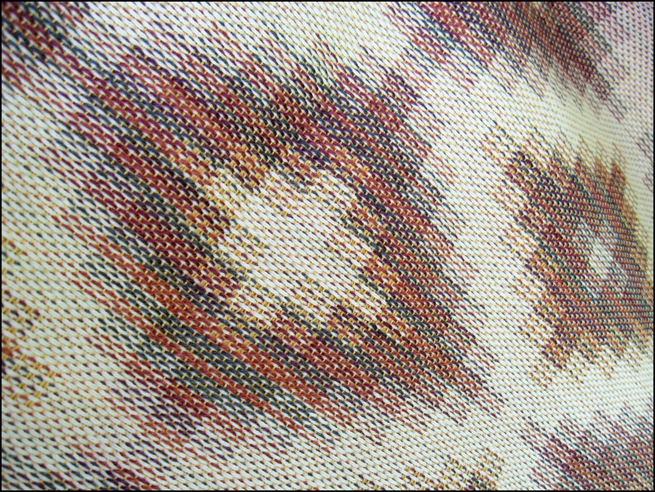
Turned Taquete Variation, fabric woven on 8 shafts, Tencel, cotton & rayon, 2015 (yellow weft version)
And here are images of the profile draft and a partial thread-by-thread draft:

PROFILE DRAFT for 8-shaft Turned Taquete Variation

Partial thread-by-thread draft for 8-shaft Turned Taquete Variation
The thread-by-thread draft is generated from the profile draft. When using Fiberworks PCW weaving software, the threading design line in the profile draft is first networked (initial 2) and then extended parallel repeat (shafts shifting by 3 not 4). The treadling is generated by simply adding plain weave, as you can see in the partial thread-by-thread draft. I wasn’t sure if I did this correctly so I emailed Marian and asked her about it, and she assured me that I did it well.
Additional notes: I used the same warp to weave both the fabric with the blue weft and the fabric with the yellow weft, alternating 8/2 Tencel (variegated colors of dark browns, reds, and purples) and 2 strands together of 20/2 off-white cotton. The blue weft is 20/2 cotton (only 1 strand, not 2 together) and the yellow weft is 20/2 rayon (also just 1 strand). The sett is 40 epi and about 28 ppi. I used a 20 dent reed, 2 ends per dent, but you can probably use a reed that’s not as fine and be able to avoid getting reed marks after wet finishing. However, I would recommend weaving a sample first and resleying if necessary because in this particular variation the finished fabric looks much better if certain warp ends are sleyed together in the same dent. For example, with my 20 dent reed I sleyed together in the same dent the ends on shafts 1&4, 2&5, etc. rather than 4&2, 5&1 etc. I think the reason for this is the way certain warp threads slide together here.
I washed the yardage by hand, spin dried in the washer, hung to dry and steam ironed. The pattern became a little less sharp than before wet finishing. The first photo above of the fabric viewed from a distance was taken after wet finishing while the close-ups were taken before wet finishing.
I was going to make something functional from these fabrics, but for now I enjoy just looking at them as they are.
Turned Taqueté Variation – 12 Shafts
Here are photos of the woven work for this project:
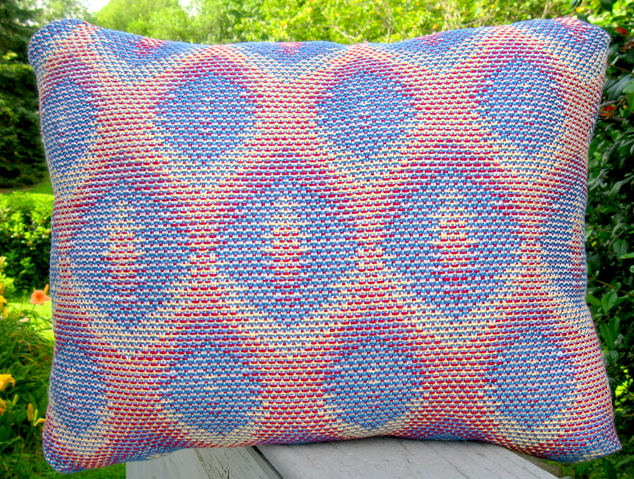
Turned Taquete Variation, fabric for pillow woven on 12 shafts, pearl cotton warp & acrylic weft, 2015
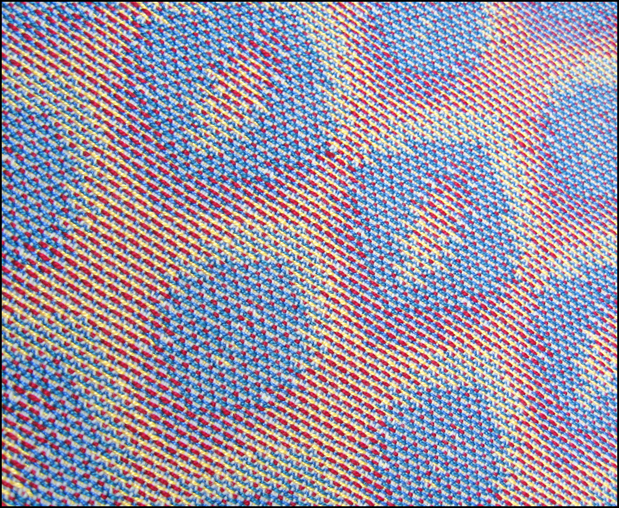
Turned Taquete Variation, fabric woven on 12 shafts, pearl cotton warp, acrylic weft, 2015

Turned Taquete Variation, fabric woven on 12 shafts, pearl cotton warp, acrylic weft, 2015 (close-up)
The warp is wound with 4 different colors of 5/2 pearl cotton yarn. You may also notice the rug in the photo, that is a summer & winter, weft-faced taqueté rug that I wove years ago:
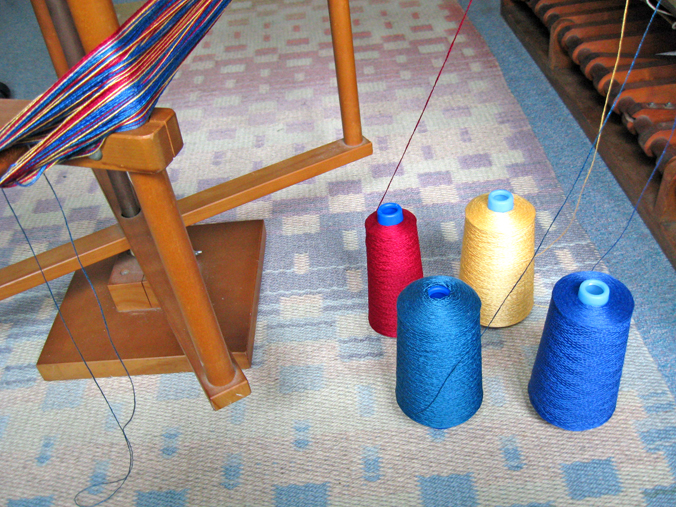
Winding the pearl cotton warp
I used a profile draft here too but made revisions to the final thread-by-thread draft until it looked like this:

Draft for 12-shaft Turned Taquete Variation (view with corrected aspect ratio)

Partial thread-by-thread draft for 12-shaft Turned Taquete Variation (interlacement view)
As mentioned earlier, I designed this variation by interleaving two threadings, actually I interleaved the same threading with itself. It may look like a turned polychrome taqueté, but Bonnie Inouye pointed out to me that the threading and tie-up would look different if that was the case.
Additional Notes: I originally wove some yardage using this draft with a very close sett of 20/2 cotton but was not satisfied with how it looked. So then I resleyed part of it with a wider sett and tied on the thicker and more lustrous 5/2 pearl cotton warp. I really like the way the four different bright colors in the warp mix with one another when they are woven together this way. The sett is 28 epi and about 20 ppi. For the weft I used a lofty white 20/2 acrylic yarn that I had in my stash. Wet finishing is the same as for the 8-shaft turned taqueté variation. I really like the little pillow I made from this yardage!
I’m not done yet with exploring turned taqueté. What’s next? Maybe a painted warp? Until then…happy weaving everyone!
UPDATE 2019: Marian Stubenitsky, author of Weaving with Echo and Iris, is now sharing some of her beautiful drafts on handweaving.net at this link.



